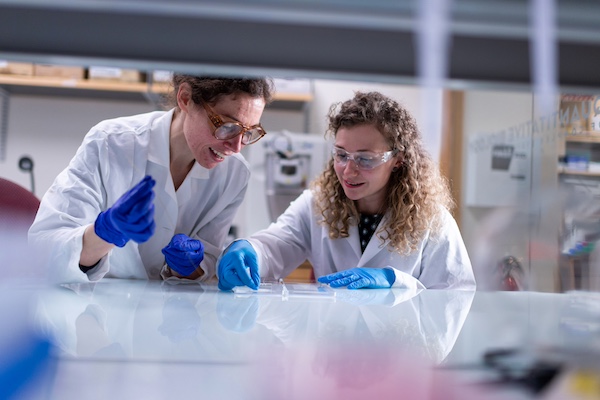Scientists at the Morgridge Institute for Research have a compelling new take on the “nature vs. nurture” continuum, revealing how the “essentiality” of a key metabolic gene varies based on the growth conditions to which cells are exposed.
The CRISPR gene editing revolution has made it possible for scientists to precisely define cellular dependence on specific genes. It’s done through a process of elimination, by snipping out different genes and measuring how cell growth responds in its absence.
CRISPR is not only helping answer fundamental questions in genomics, it can also identify “targets” that can help fight diseases such as cancer, Parkinson’s and a host of genetic disorders.

But it’s only half the story. Morgridge researchers in the lab of Investigator Jason Cantor have shown that the nutrient-rich solution used to grow cells in a dish — known as growth medium — also plays a role in shaping cell behavior.
The common growth media used across scientific research were developed more than 70 years ago and support rapid cell growth but under biochemical conditions very different from those cells may face in the human body. Cantor created a reagent called Human Plasma-Like Medium (HPLM), to more accurately mimic human cellular growth conditions in a dish.
Reporting in the May online issue of the journal Nature Metabolism, the team combined the powers of both technologies — CRISPR and HPLM — to understand why the relative importance of a specific gene for supporting cancer growth further depended on cell culture in HPLM versus conventional media. The study focused on the enzyme NADK, which plays a key role in reductive metabolism, by helping to mediate the cytosolic production of NADPH, a coenzyme critical to a variety of cellular processes.
Given the crucial role that NADPH plays across a broad array of key metabolic, NADK has received attention as a high-interest potential target for cancer therapy.
Interestingly, CRISPR studies of hundreds of cancer cell lines, using conventional culture media, showed that cancer cell growth continued unabated when NADK was deleted. By contrast, cancer growth was dramatically impaired when these same NADK-deleted cells were grown in in HPLM.
That interaction between genetic instructions and environmental conditions provides a powerful barometer for how to guide effective therapies. In this study, they found that the availability of folic acid — a key vitamin that promotes cell growth — largely dictated NADK dependence. Notably, most conventional media provide folic acid at levels much higher than those found in human blood.
“This study provided further evidence that conditional gene essentiality can be leveraged to gain insights into protein function and cell metabolism,” notes Kyle Flickinger, a UW-Madison Biochemistry PhD, Cantor Lab scientist and lead author of the study.

“Despite accumulating evidence that gene essentiality can also depend on cell growth conditions, there is still often little consideration into how the metabolic environment influences gene essentiality in proliferating human cells,” Flickinger adds.
As a reference point, the study highlighted cataloged data from the Broad Institute’s DepMap Project, which contains genetic dependency information for more than 1000 human cancer cell lines. While scientists have long known the connection between NADK and cancer, NADK was annotated as an “essential gene” in only 2 percent of the nearly 1,200 CRISPR screens from the DepMap database.
“NADK really controls a lot of things, especially for cells that need to grow and divide quickly,” Flickinger says. “So, for a long time, people thought this could make a really good anti-cancer target. But for whatever reason, they were never able to show much of an effect in cancer cells.”
Now that this study shows a finely-tuned connection between NADK and the right levels of folic acid, it gives drug developers another important factor to consider, he says.
Cantor says that the HPLM-based studies also could provide a better mechanistic understanding of how existing chemotherapies work in the body. Many of the classic chemotherapies were developed several decades ago, long before the new fleet of biomolecular tools were available to science.
“There’s a lot more than meets the eye that becomes possible when you actually know what’s going on under the hood,” he says. “This study is a great example for demonstrating how mechanistic insights otherwise masked by traditional models can be uncovered by looking at metabolism at the molecular and cellular levels through a different and likely more relevant lens.”

